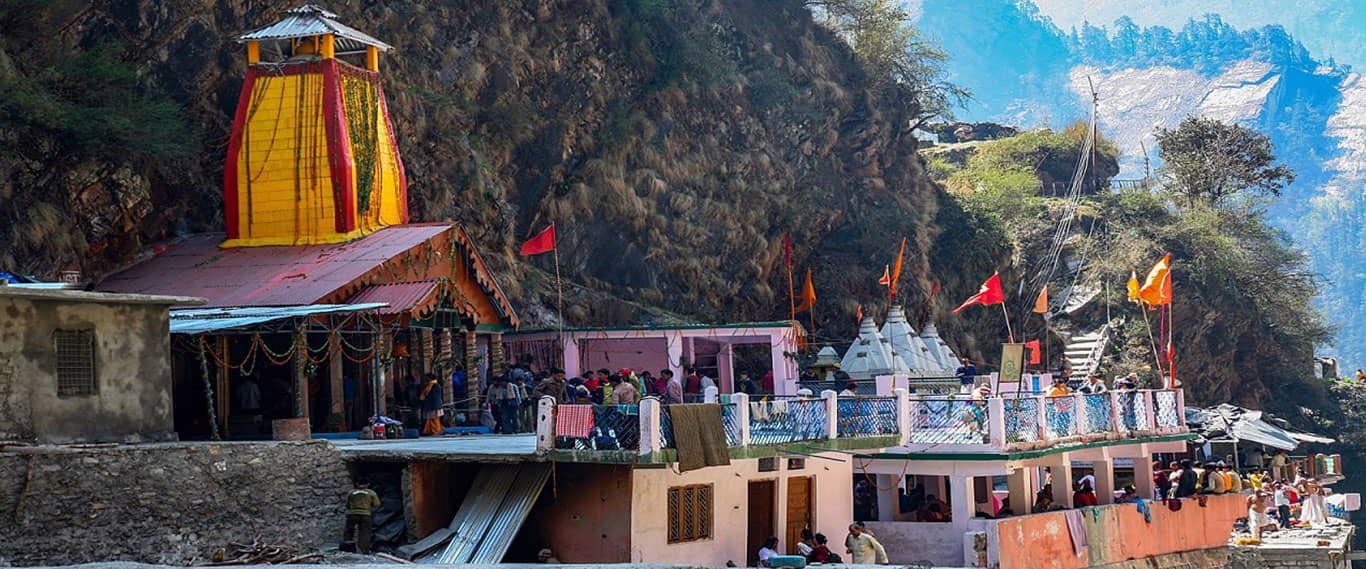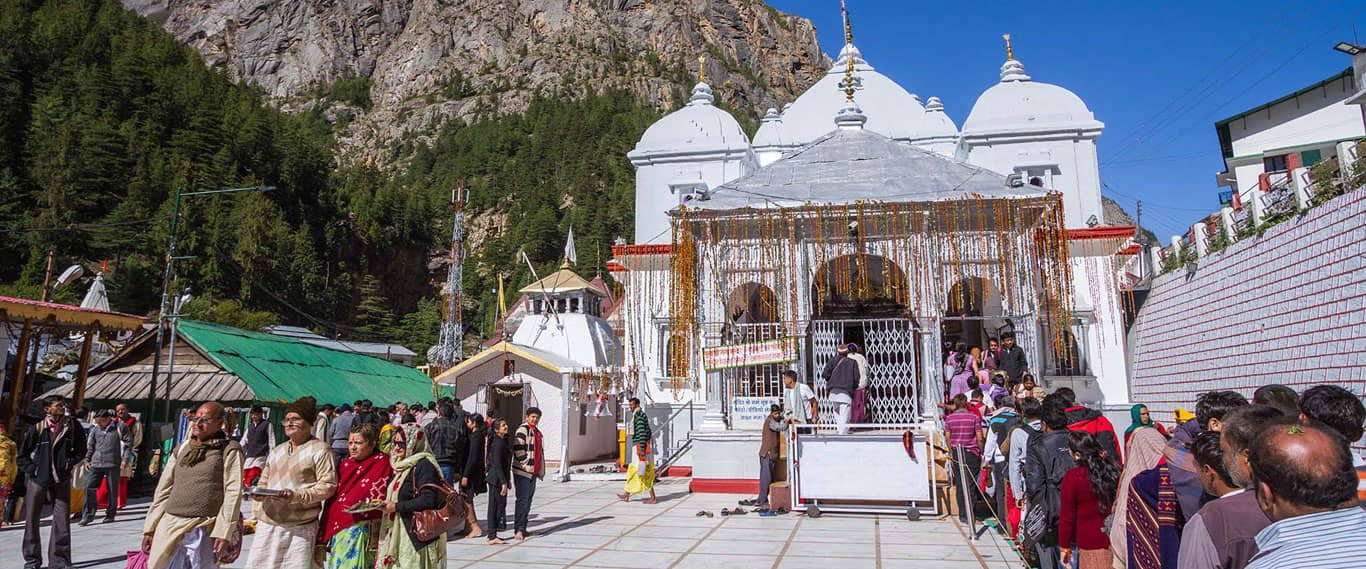Shree Yamunotri and Shree Gangotri DhamYatra
04 Night / 05 Days
Overview
Shree Yamonotri Dham It's said that the Yamunotri Shrine is where the Yamuna River begins. It has Bandar Poonch peak'seastern flank on top (3615 meter). Although it is only an additional 1 km up the mountain, the real starting point is a frozen lake of ice and glacier (Champasar-Glacier) on the Kalind Mountain at 4421 metres above sea level. As a result, the sacred site has been situated at its base on the hill.
Maharaja Pratap Shah of Tehri Garhwal reconstructed the Goddess Yamuna Temple. That deep reverence, which Yamunotri has for the devout, is further enhanced by the icy cold water of the small Yamuna. The ancient sage Asit Muni lived here as a hermit, according to the star. like the view from the Yamunotri trek, which is dominated by towering peaks and dense forests.
Black marble adorns the figure of Goddess Yamuna. The temple is dedicated to the river Yamuna, who is depicted in the form of a garlands-adorned silver statue. If you're ever close to a hot springs, you've probably heard of them. This is the most important Kund.
Divya Shila, a shila located near Suryakund, is worshipped before offering prayers to the deity. Pilgrims dip rice and potatoes in these hot water springs and tie them in muslin cloth to offer at the shrine. As prasadam, the rice is brought back to the family.
Shree Gangotri Dham In Hinduism, the holy river Ganga (Ganges) originates in Gangotri, one of the four Char Dham pilgrimage sites. Gaumukh, a glacier located 19 kilometres away from Gangotri temple, is the river's primary source. One of the world's most sacred rivers is the Ganga.
Built in the 18th century by Gorkha General Amar Singh Thapa, the Gangotri temple is situated on the Bhagirathi River's left bank. There are deodar and pine trees surrounding the temple. Bhagirath Shila, the holy rock where King Bhagirath worshipped Lord Shiva, is just a short walk away.. Goddess Ganga is the focus of the Gangotri temple.
The Gangotri water is brought to the temple of Lord Shiva. The belief is that Shiva's throat will be soothed by this nectar-laced water if he gulps down the poison.
Details Itinerary
Day 01 Rishikesh to Barkot HT: 1352 MTS, 170 km/ 6 hours.
After Morning Ganga Bath, Having breakfast straight drive to Barkot via Mussoorie, en route will visit Kempty Fall (Suggestible to have your lunch at Kempty fall), Continue Straight drive to Barkot, After reaching to your Hotel, Rest of the day is free to have relax for the next journey ,With having Dinner overnight stay at Barkot.
Barkot - is well-known for its striking natural beauty. Situated at the merging point of Yamuna with tons of rivers. Barkot offer panoramic views of the snowcapped mountain of Bandar Poonch. Among the Char Dham Pilgrimages, Barkot serves as a major rest stop on the way to Yamunotri .
Barkkot Weather – usually pleasant in summer, the temperature range from 25-30 0 C, winter: The Days are enjoyably cool but during the night temperature gets cold,and ranges from 10 deg to 05 deg.
Day 02 Barkot-Yamunotri-Baktot 36 kilometers by car and 6 kilometers by foot: Elevation : 3293 meter.
Next day after having breakfast, continue to Hanuman Chatti and take local jeep for Janki chatti, from from Janki chatti will start trekking for Yamunotri Ji (Either by hike or by horse at own cost). On entry in Yamunotri Dham “Darshan” of pious “Yamuna ji”. After “Puja” (worship) will drive back to barkot. Will have Dinner and overnight stay at hotel in Barkot.
Note : 06 km trek one side From Jankichatti
Yamunotri Weather – During the summer, the high is 18 degrees Celsius and the low is 10 degrees. The days are mildcold but the nights are often cold.
Day 03 Barkot to Uttarkashi 100kms / 4hrs. Elevation: 1158 meter.
After having Morning breakfast will start drive to Uttarkashi and check- into the hotel in Uttarkashi. And after check-in will visit Kashi Vishwanath Temple in Uttarkashi. In Night will take Dinner and stay at Uttarkashi overnight.
Uttarkashi - is home to a quantity of Ashrams and temples. The name of the town reveal its comparison to and location (as north of) the city of Kashi (Varanasi). Similar to Varanasi town of Uttarkashi is also located on the banks of River Ganga.
Vishwanath temple – The Vishwanath Temple in North India is one of the most ancient Shiva temples in india. The structure was rebuilt in 1857 by Maharani Khaneti Devi of Tehri District in the state of Uttarakhand in an extremely old architectural style. It is conveniently positioned in the middle of the city. A massive iron trident, symbolic of the holy mother's, has been at the temple compound since the beginning of time and is still revered today. The minor shrines of Ganeshji, SakshiGopal, and Markandeya Rishi are also located within the temple compound. AkhandJyoti and AkhandAbhishek, as well as arti in the morning and evening, are both presented. Lord Shiva's residence during the Kaliyug , Uttarkashi, is referred to as 'Saumya Varanasi' in the SkundaPuran, and it is one of the twelve Jyotirlingas.
Shakti temple – Right in face of the Vishwanath templeShakti temple is situated. It has a large size of ‘Trishul’ of about 6 meters in height and a perimeter of 90 cms. at bottom. Though there are different views about the make of this, the upper part of it seem to be made up of iron and the lower one is of copper. As per the epic this Shakti was fearful on the devils by the spirit Durga(Shakti), that's why it gets its name. Since then, this Shakti has been erected in this location.
Uttarkashi Weather – Temperature ranges from 30 to 35 degrees Celsius in the summer, but the nights are lovely.
Day 04 Uttarkashi – Gangotri – Uttarkashi (100kms /3 hrs each side) Elevation : 3415 meter.
In the early hours morning drive to Gangotri, on the way at Gangnani take a sacred dip in GaramKund, and then drive to Gangotri via attractive Harsil Valley, Nature lovers flock to Harsil to take in the area's stunning views of the Deodar trees and surrounding mountains, which are well worth the trip. When you reach Shree Gangotri, take a holy bath in the holy river. Ganges which is also called Bhagirathi at its source. Pooja and Darshan, after that relax for some time in the lovely surrounds. Later drive back to Uttarkashi. Dinner overnight stay at Uttarkashi.
Gangotri Weather – The maximum high temperature during summer can go up to 20° Celsius. Summer night can get cooler with a minimum temperature of 10° Celsius. Light woolen dress are necessary while visiting Gangotri during summer. Winter season is very chilly in Gangotri. Gangotri will be cover in sheets of snow for the duration of winter. Pilgrim center remains closed throughout winter due to heavy snow falls.
Day 05 Uttarkashi - Rishikesh (170 kms/ 5-6 hrs) Elevation: 340 meter.
After having Morning Breakfast will proceed for Rishikesh on the stop for lunch in Tehri lake,after lunch drive to Rishikesh if time permit to Join Ganga Arti , after Aarti will drop to you Rishikesh Station or Bus Stand for your Next Destination, yatra end here !
Book This Tour
Why Book With Us?
- No-hassle best price guarantee
- Customer care available 24/7
- Hand-picked Tours & Activities
- Expert Driver in Hill Road
Get a Question?
Do not hesitage to give us a call. We are an expert team and we are happy to talk to you.
+91 9837285788 sagartour@rishikeshyatra.com

